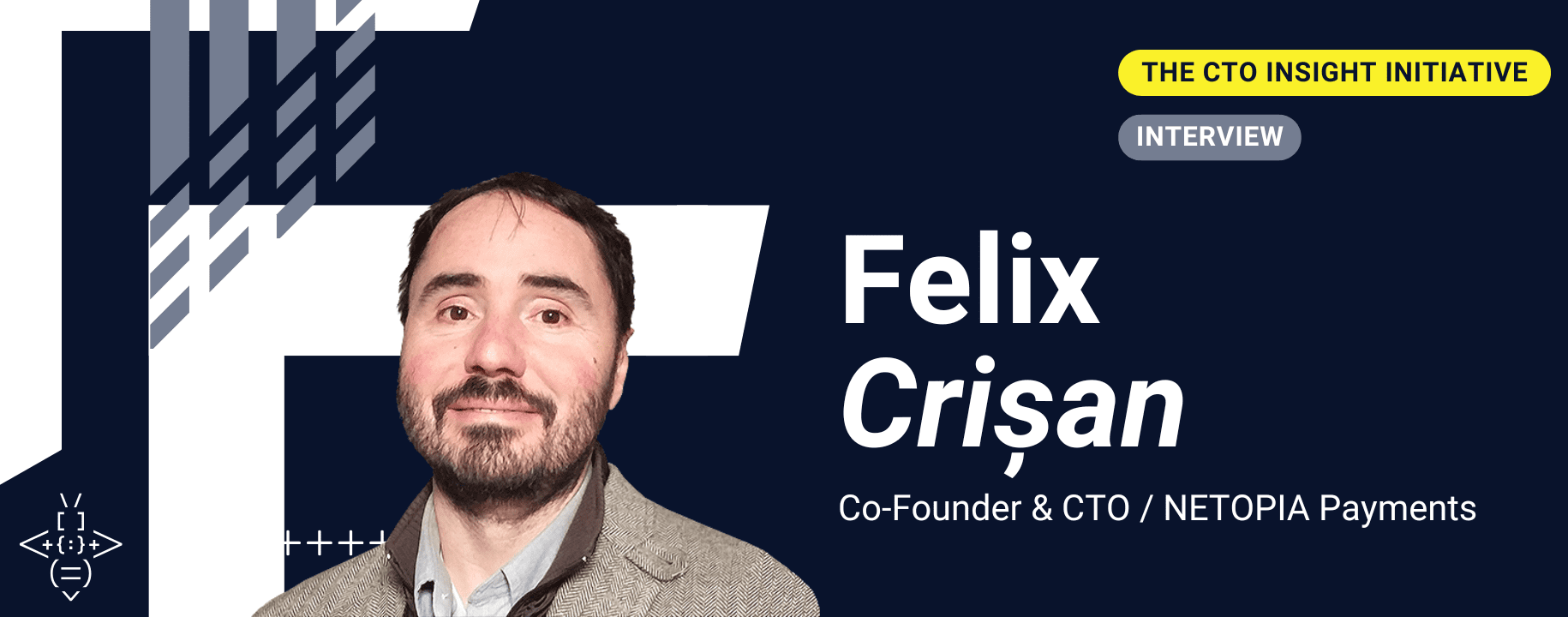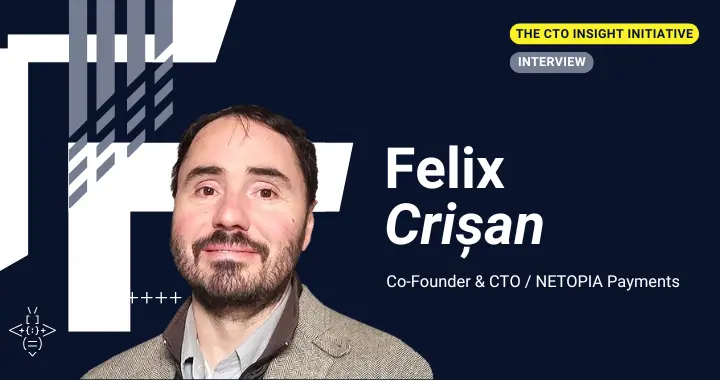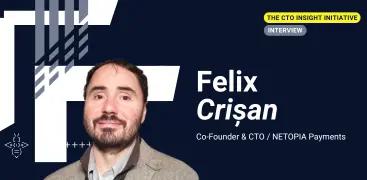- Industry insights
- People in tech
- 31 Mar 2025
The CTO Insights Initiative | Felix Crisan – Netopia
As technology evolves, so do the challenges of a CTO.



Table of contents
Contributors

Introduction
As technology evolves, so do the challenges of a CTO.
We sat down with Felix Crisan, co-founder and CTO of Netopia Payments, an industry veteran with a unique perspective on today’s technology challenges.
He shared insights about his journey and the lessons he’s learned along the way. Let’s take a look together at the most important CTO insights we’ve noted from Felix.
The Tech Journey – Opening Doors to Knowledge
For Felix Crisan, the road to technology has been one of discovery and knowledge. His first interaction with the internet was as a college student. “What stuck in my mind back then and what I found very fascinating was that all of a sudden you had access to all the knowledge from all over the world,” he says.
This curiosity took him to different corporations, where he learned about the invisible but essential infrastructure of modern technology. “People today have a phone, but they don’t know that behind it are all kinds of systems that need to be highly available,” Felix explains.
As the products evolved, so did his role, building on a solid foundation of technological advancement. When we asked him what helped him progress and stand out over 27 years, Felix told us: “What helped me progress was the fact that I was always looking at new things and had a high level of openness to new technologies.”
Being open to change and continuously learning to keep up with technology is very important, especially in today’s world, when the evolution of technology is more accelerated than ever.
Advancement in AI: Quick Wins vs. Long-Term Wins
A tricky topic for any CTO is how to find the balance between quick fixes and long-term progress, especially in the AI field. Felix emphasizes that quick fixes are useful in the beginning, especially for a startup, which needs to validate its product quickly in the market. In this phase, it’s not so much about how the product works in the long run but how it can be improved quickly to attract users and solve problems immediately.
As the startup grows and stabilizes, you need long-term solutions – that is, more stable and powerful technologies that support the product in the long term: “As things mature and you need stability, you need solutions that stand the test of time. Today, these AI capabilities don’t yet exist at the best level, but in 3-5 years, things will change radically,” he estimates.
In-House Teams vs. Third-Party Providers
Another crucial aspect for a CTO is the decision of whether to build in-house teams or to use external providers. Felix emphasizes that he never recommends that a startup depend solely on external teams: “It is mandatory to have at least one in-house technical person who knows exactly what needs to be done“.
However, there are scenarios where working with external teams can be successful if done strategically. “We had a project where we hired external developers, but with clear technical specifications written by our internal colleagues. The final product was then taken in-house and refined“, he says. Outsourcing, therefore, works best when there is a clear plan and solid in-house know-how. These CTO insights reinforce the idea that having an internal tech team is crucial, even when external collaborations are involved.
Building Trust in Technical Partners
When asked what makes him trust a development partner, Felix shared: “Trust can come from recommendations, but it can also stem from experience, such as having worked in your field with seven of your competitors or in the technology you’re interested in with 10 major companies.“
We also asked him about his experience in building and scaling his team. Felix talked to us about the importance of stable teams and people in middle management in a company, explaining that employee perseverance and loyalty are very important for the long-term success of a company. Thus, keeping loyal and experienced employees can ensure continuity of knowledge and performance in a company.
An Unexpected Lesson
Felix shared an important lesson with us about the difference between deep and broad engagement. In the early stages of his business, he and his partner were directly involved in every decision, which brought a lot of pressure. However, as the business grew and management was outsourced, their involvement became less direct. In this sense, Felix told us, “In one way, you feel the pressure when you do things yourself, and in another way, you feel the pressure when you do things for others.“
Felix made another important point about the difference between a great programmer and an effective manager. He noted that while a programmer may be extremely technically talented, this does not guarantee that he or she will also be a good manager: “A very good programmer will not always be a very good manager“. These CTO insights remind us that leadership skills and technical expertise do not always go hand in hand.
In his experience, not all programmers are ready or willing to manage teams. In fact, a very good programmer may have difficulty when it comes to managing other people because management requires a different set of skills, including communication, leadership, and organization. It is, therefore, important that as teams grow, there is a separation between technical and management skills.
Conclusion
Felix Crișan shared valuable CTO insights in an ever-evolving technological landscape. Here is a summary of the lessons we learned from him:
- Adaptability and openness to knowledge are very important in an ever-evolving tech landscape.
- A great programmer doesn’t automatically make a great manager.
- In-house technical teams are essential, even when collaborating with external providers.
Explore more insights from industry experts in our People in Tech articles.
Retention Engineering: Data-Driven Strategies to Reduce Churn in SaaS Products
Designing for Conversion: UX Principles That Transform SaaS Trial Users Into Paying Customers
Building User Trust: Transparency and Communication in SaaS Security